2020 is an excellent year for .NET. This is the year we'll finally see .NET 5 merging .NET Core, .NET Framework and Xamarin.
2020 brings great news for .NET developers. This is the year that, Microsoft expects to consolidate .NET Core and .NET Framework on a single platform called .NET 5 including .NET mobile (Xamarin), ASP.NET Core, Entity Framework Core, WinForms, WPF and ML.NET.. The first preview is expected in the first half of the year with the official release foretasted for Nov, 2020. Excited? You should be!
Update: The first beta release is available now!
Great news for .NET developers
That's great news for folks working on .NET Core since there'll be an influx of projects to work, contribute and develop. But that's even better news for teams working on slow-moving projects (aka, most of us) which have been deferring an update to the more modern, faster and container-friendly .NET Core.I posted some time ago my insights regarding this update. TLDR, I'm super excited! Being a long time Fedora Linux user and a big open source enthusiast, I have been using .NET Core for my personal projects on Linux (and running them successfully on both Docker, AWS and Azure). While I'm transitioning more and more my workflow to open source software (such as Vim, i3, etc) and and have been working a decent portion of my time with Go and Python, .NET is still my default framework.
So let's take another look at what's coming up next with .NET.
Highlights of .NET 5
Apart from the single codebase, my preferred highlights of .NET 5 are:- .NET will become a single platform including Xamarin, ASP.NET Core, Entity Framework Core, WinForms, WPF and ML.NET
- Unified .NET SDK experience:
- Single BCL (Base Class Library) across all .NET 5 applications. Today Xamarin applications use the Mono BCL but will move to use the.NET Core BCL, improving compatibility across our application models.
- Mobile development (Xamarin) is integrated into .NET 5. This means the .NET SDK will support mobile. For example, you can use “dotnet new XamarinForms” to create a mobile application.
- Native Applications supporting multiple platforms: Single Device project that supports an application that can work across multiple devices for example Window Desktop, Microsoft Duo (Android), and iOS using the native controls supported on those platforms.
- Cloud Native Applications: High performance, single file (.exe) <50MB microservices and support for building multiple project (API, web front ends, containers) both locally and in the cloud.
- Open source and hosted on GitHub
- Cross-platform and better performance
- Decent command-line interface (CLI)
- Java, Objective-C and Swift interoperability
- Support of static compilation of .NET (ahead-of-time – AOT)
- Smaller footprints
A Unified Platform
This is a more holistic view of what .NET 5 will be:The Schedule
The proposed merge is expected to happen by November 2020. Here's the plan:You can also check the release status in real time on GitHub (Jan, 2020):
What's Next
So what's next? Well, the best thing to do is to keep an eye on .NET's official blog as they'll be updating the status of the project through there. Would you like to contribute? Jump into .NET Core and CoreFx repositories in GitHub. For more information on the topic, consider reading .NET Core and .NET merging as .NET 5.0.References
See Also
- Adding Application Insights telemetry to your ASP.NET Core website
- Creating ASP.NET Core websites with Docker
- Send emails from ASP.NET Core websites using SendGrid and Azure
- Hosting NuGet packages on GitHub
- Package Management in .NET Core
- Configuration in .NET Core console applications
- How to Build and Run ASP.NET Core apps on Linux
- How to create a Ubuntu Desktop on Azure
- Windows Subsystem for Linux, the best way to learn Linux on Windows
- Why I use Fedora Linux
- How I fell in love with i3








